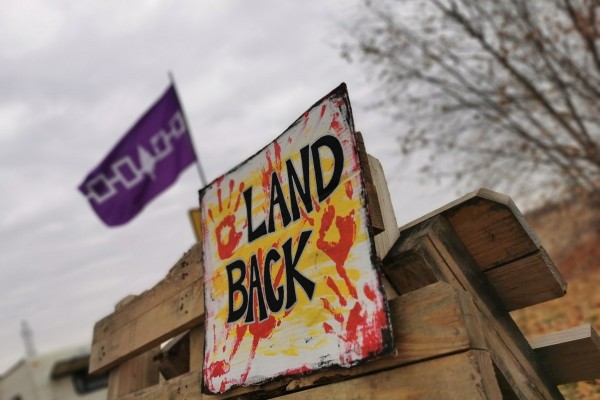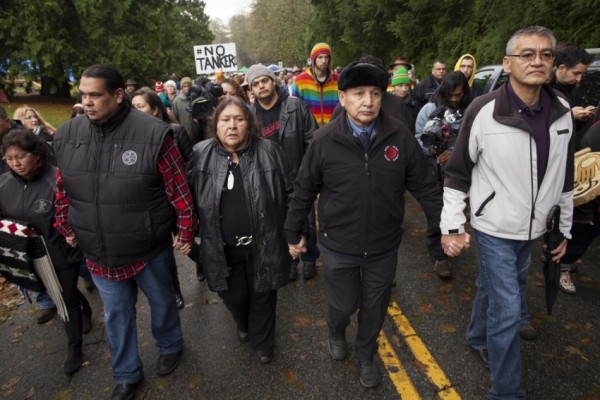Pacification by pipeline

Photo courtesy of Tiny House Warriors, Facebook.
“We are a nation of pipelines,” proclaims Chris Bloomer, president and CEO of the Canadian Energy Pipeline Association, in a 2017 newsletter. This notion is echoed in the position taken by the federal government, both publicly and behind closed doors, to the effect that energy infrastructure, like pipelines, is in the “national interest.” This claim has been made explicitly in relation to the Trans Mountain Pipeline expansion (TMX) project.
Consider this rhetoric against the backdrop of the arrest of Secwepemc land defender Kanahus Manuel in July 2018, not long after the federal government purchased the TMX project. The RCMP were enforcing an eviction order, issued by B.C. Parks against the Tiny House Warriors, whose village of tiny houses asserts Secwepemc jurisdiction in the path of the intended project. One of the conditions of Manuel’s release was to stay away from the site — her own territory. In contestations over infrastructure projects, the violence of Canadian nation-state building is starkly evident. The criminalization of Indigenous land and water defenders, and non- Indigenous allies, who are “in the way” of national infrastructure projects is certainly not new, but now it’s taking place at a time when “reconciliation” has become a significant part of public and political discourse in Canada. In the case of TMX, the “national interest” looks increasingly like a pretext for government to resort to exceptional measures to expand the pipeline while pretending to espouse a politics of reconciliation.
Infrastructure “in the national interest”
If Canada is a nation of pipelines, it is also a nation of railways, dams, electrical grids, mines, and highways. Large- and small-scale infrastructure projects have been integral to settler colonialism and the formation of the Canadian nation-state. Infrastructure forms part of the national imaginary as a celebration of technological innovation and the conquest of the land. Erased by these narratives is the violence of dispossession, exploitation, and criminalization enacted by state institutions to build and maintain this infrastructure. Also buried in the celebratory stories of modern engineering are the dire health and environmental harms caused by infrastructure. Furthermore, in the uneven patterns of its construction, infrastructure sustains certain human and economic lives while excluding and neglecting others.
The government’s explicit framing of TMX as being “in the national interest” and their declarations of exclusive federal jurisdiction overriding Indigenous, provincial, and municipal opposition are noteworthy. By positioning pipelines as an essential feature of Canadian nationhood, they also inadvertently highlight the ongoing violence of settler-colonial nation building. Prime Minister Justin Trudeau has repeatedly emphasized the “national interest” in defending approval of TMX and his government’s decision to purchase the project from Kinder Morgan in the face of the company’s threat to abandon it. Prior to the purchase, he bluntly stated: “It will be built.” Members of his cabinet have similarly defended the project. Finance Minister Bill Morneau described TMX as being of “vital interest to Canada and Canadians,” and said that, “when we are faced with an exceptional situation that puts jobs at risk, that puts our international reputation on the line, our government is prepared to take action.” Echoing Trudeau, Morneau declaimed: “Our government’s position is clear: it must be built, and it will be built.”
The rule of law and national security
Talking about what it will take to “get things done” in the wake of the TMX approval in December 2016, Natural Resources Minister Jim Carr told an audience of industry proponents: “If people choose for their own reasons not to be peaceful, then the government of Canada, through its defence forces, through its police forces, will ensure that people will be kept safe,” and, “if people determine for their own reasons that that’s not the path they want to follow, then we live under the rule of law.” In April 2018, former Alberta energy minster Rick Orman stated that the only way to ensure the TMX project’s construction would be by “militarily asserting jurisdiction.” Critics were quick to point out that the government doesn’t have the authority to deploy military forces to quell peaceful protests. Both Trudeau and Morneau have also insisted on adherence to the rule of law. But this doesn’t necessarily rule out the use of police — as we’ve already seen — or the military to see the project through. While Canada’s rule of law has brought a temporary legal stop to physical construction via the Federal Court of Appeal’s overturning of the TMX approval, this same rule of law has enabled injunctions, eviction notices, arrests, and detentions of land and water defenders in Secwepemcúl’ecw and beyond.
The criteria for what constitutes “non-peaceful” protest have arguably broadened, as critical infrastructure, including pipelines, has come to be defined, since the early 2000s, as a core focus of national security. The possibility of calling in the armed forces could therefore be seen as legitimate if jeopardizing the TMX is considered a threat to Canada’s national security. This is why the Canadian government’s insistent messaging of “national interest” and national jurisdiction right now is so significant.
How can something that doesn’t exist be a matter of national security? Here Morneau’s comments are revealing. He emphasizes the urgency of purchasing TMX to secure Canada’s economic future: “when we are faced with an exceptional situation that puts jobs at risk, that puts our international reputation on the line, our government is prepared to take action.” This statement reflects the logic underlying Canada’s current critical infrastructure security policy, which has roots in war-time national defence strategy.
Trudeau’s and Morneau’s description of the (yet to be built) pipeline infrastructure as “vital” evokes the historical Vital Points defence program, which was established during World War II and extended into the Cold War period. The program identified physical infrastructure that was deemed essential to war efforts, including defence installations and industrial “vital points,” such as railways, canals, docks, grain elevators, and hydroelectric plants. Because these would be strategic targets for attack or sabotage by enemies during war or by “subversives,” they were prioritized for protection by National Defence and the RCMP.
In 1971, a parallel program was created, concerned primarily with internal threats. The two Vital Points programs were gradually reorganized in the 1980s by merging the war (national security) and peace (emergency management) sections. The protection of vital points — re-conceptualized as “critical infrastructure” — now has a common security architecture as a national security priority. Reflecting the significant growth and expansion of infrastructure systems over time, and their increased interdependencies, critical infrastructure security is now defined as more than physical points — it includes “processes, systems, facilities, technologies, networks, assets and services essential to the health, safety, security or economic well-being of Canadians and the effective functioning of government.”
Kanahus Manuel
at left, Tiny House
Warriors, Facebook.
Risk management
One feature of this reorganization is the adoption of an “all-hazards” risk management approach in the early 2000s, which emphasizes prevention and preemption strategies to secure infrastructure from all types of threat, ranging from extreme weather events to “malicious actors.” Within this framework, mobilizations against infrastructure projects may fall within the scope of national security because of the possibility that direct actions might either cause physical damage to critical infrastructure, or might disrupt their circulation, by, for example, disrupting flows of trade considered “essential to economic well-being.”
While law enforcement and intelligence agencies assert that peaceful protests do not fall within this scope, surveillance of Indigenous communities and environmental justice movements has been widely documented by activists, academics, and journalists. These practices have been rationalized as consistent with the national critical infrastructure security policy emphasis on identifying and dealing with possible risks in a preventative and pre-emptive manner. Because Indigenous jurisdictions pose enduring uncertainties for the Canadian state and, therefore, riskiness for infrastructure projects, the implication is that Indigenous communities and defenders are more likely subjected to surveillance by law enforcement, government departments (particularly Indigenous Affairs), and industry. With the implementation of the “all-hazards” approach, for example, Indigenous and Northern Affairs Canada formalized a system of monitoring what they refer to as “civil unrest” involving Indigenous communities and issues. This information is shared with law enforcement and other government departments.
Protecting the market economy
While vital to the life of (certain) populations, infrastructure also sustains global capitalism as the means and products of extraction, production, and trade. Approximately eighty-five percent of Canada’s critical infrastructure is privately owned or operated, meaning that this national security priority is highly dependent on the private sector. One of the main objectives of Canada’s National Strategy and Action Plan for Critical Infrastructure has been to foster stronger partnerships with owner-operators and industry stakeholders. From 2007 to 2014, the priority was to increase the degree of information and intelligence sharing between government, law enforcement, CSIS, and owner-operators to support risk management. Since 2014, Canada’s critical infrastructure policy has increasingly emphasized the need to go beyond protecting existing infrastructure to building so-called resilience.
The buzzword “resilience” has become ubiquitous in many areas of social life and generally has a positive connotation. Why would we not want to be resilient — namely, able to withstand and rebound from adverse conditions? Applied to critical infrastructure, the resiliency approach adds another set of strategies to the national security toolbox of surveillance, intelligence production, and disruption of threats. To develop resilience, owner-operators are encouraged to engage in continuous assessment, modification, enhancement, and augmentation of infrastructural capacities. The objective is to preempt the potential disruptions that might occur as a result of future threats, whether caused by extreme weather events associated with climate change, hackers, or blockades. Increasing public and private investment in new or expanded critical infrastructure to ensure resiliency is therefore being promoted as a national security strategy.
Serving our future
The TMX, like other proposed extractive projects, is a type of anticipatory infrastructure consistent with a certain vision of the future of the nation-state. In Morneau’s view, the possible loss of jobs and harms to Canada’s international reputation are anticipated risks to the country’s economic well-being based on a future of expanded energy markets that TMX promises to bring into being. From the vantage point of critical infrastructure resilience, imagined future risks provide justification for pre-emptive action in the present as a matter of national security.
The federal government’s assertion that TMX is of “national” and “vital” interest is rooted in an anticipated national future. Secwepemcúl’ecw has been subjected to the violence of numerous colonial infrastructure projects going back to the construction of the Canadian Pacific Railway, which enabled the processes of settler expansion and intensified resource extraction that underlie the current struggle against TMX.
While the Supreme Court has affirmed Aboriginal rights and title (most recently, in Tsilhqot’in Nation v. British Columbia), it has also been consistent in maintaining that infringement can be justified by a “compelling and substantial public purpose,” including infrastructure development. The Federal Court of Canada overturned approval of the TMX project on the grounds that the federal government had failed to meet its constitutional duty to meaningfully consult with affected First Nations communities; however, the framing of TMX as vital to the national interest, and further cloaked with a national security rationale of ensuring critical infrastructure resilience, could make infringement all the more compelling. At the same time, it provides the justification, within Canada’s legal framework, to take measures to prevent opponents from disrupting Canada’s imagined energy future by defining them as threats to (future) national security.
Tia Dafnos is an assistant professor in the Department of Sociology at the University of New Brunswick (Fredericton) on the unsurrendered, unceded territory of Wolastoqiyik.
This article appeared in the Fall 2018 issue of Canadian Dimension (An Unjust Justice System).










